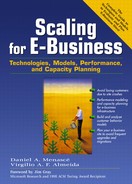12.5. Forecasting Strategies
The difficulty associated with providing accurate forecasts for electronic business stems from the weak relationship between future and past experience because access paradigms change constantly. For instance, consider the hypothetical case of an online bookstore that has tracked the evolution of its customer base on a monthly basis over several months. The evolution of the customer base can be useful for forecasting future demands as long as the online store does not change its business model. Consider now that the bookstore opens an online mall to sell merchandise ranging from auto parts to shoes. In this new business model, books become just one category of items sold in a large online mall. The history of its customer base may not provide insight into future demands because the new business model may have broken the connections between past and future.
In electronic business, management has to be careful when using forecasting methods [5]. Instead of working with a few planning scenarios that consider high, medium, and low probability events, one should also consider events with very low probability but whose impact on the business could be enormous. This is a consequence of the high variability phenomenon discussed before. Suppose that a company is planning its e-commerce site for the launch of a new game. Management is considering three basic scenarios. The optimistic one assumes 900,000 customers visiting the site in the first day. The most likely scenario predicts 500,000 customers downloading the game in the first day. The pessimistic scenario estimates that no more than 100,000 customers will access the site in the first day. Instead of concentrating only on these three scenarios, which were drawn from numbers collected during previous game launches, management should also be asking questions such as how the site will behave if two million customers visit the site in the first day. Although the probability of getting such a number of customers is considered very low, the consequence of having two million customers would be disastrous if the site did not have enough capacity to handle the load. Therefore, management should prepare for contingencies, such as a huge number of customers trying to download the game.
Forecasting methods can be divided into two approaches, namely quantitative and qualitative. Figure 12.4 illustrates how these two approaches fit in the forecast strategy. Quantitative methods rely on the existence of historical data to estimate future values of the workload parameters. The qualitative approach is a subjective process based on market surveys, judgement, intuition, business plans, expert opinions, historical analogies, commercial knowledge, and any other relevant information. The quantitative approach makes use of forecasting techniques discussed in next section. Values obtained through the use of forecasting techniques should be adjusted by factors, such as peak traffic ratio, obtained by using the qualitative approach.
Figure 12.4. A Forecast Strategy Model.

